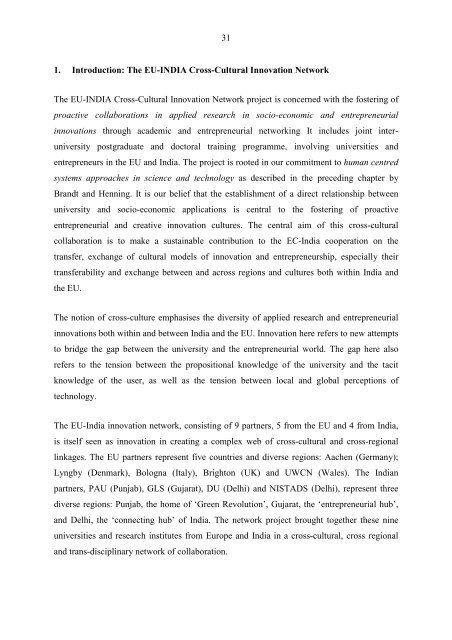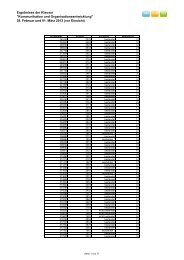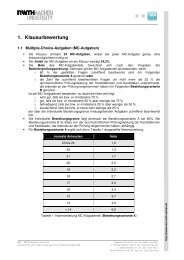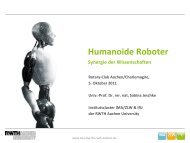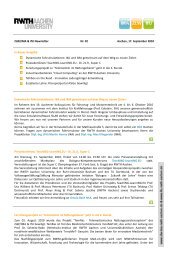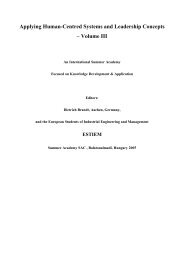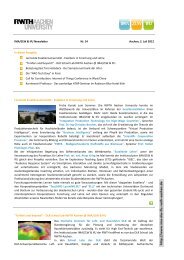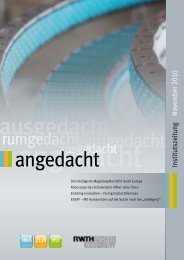Vol. II: Shaping Information and Communication ... - IMA,ZLW & IfU
Vol. II: Shaping Information and Communication ... - IMA,ZLW & IfU
Vol. II: Shaping Information and Communication ... - IMA,ZLW & IfU
You also want an ePaper? Increase the reach of your titles
YUMPU automatically turns print PDFs into web optimized ePapers that Google loves.
31<br />
1. Introduction: The EU-INDIA Cross-Cultural Innovation Network<br />
The EU-INDIA Cross-Cultural Innovation Network project is concerned with the fostering of<br />
proactive collaborations in applied research in socio-economic <strong>and</strong> entrepreneurial<br />
innovations through academic <strong>and</strong> entrepreneurial networking It includes joint interuniversity<br />
postgraduate <strong>and</strong> doctoral training programme, involving universities <strong>and</strong><br />
entrepreneurs in the EU <strong>and</strong> India. The project is rooted in our commitment to human centred<br />
systems approaches in science <strong>and</strong> technology as described in the preceding chapter by<br />
Br<strong>and</strong>t <strong>and</strong> Henning. It is our belief that the establishment of a direct relationship between<br />
university <strong>and</strong> socio-economic applications is central to the fostering of proactive<br />
entrepreneurial <strong>and</strong> creative innovation cultures. The central aim of this cross-cultural<br />
collaboration is to make a sustainable contribution to the EC-India cooperation on the<br />
transfer, exchange of cultural models of innovation <strong>and</strong> entrepreneurship, especially their<br />
transferability <strong>and</strong> exchange between <strong>and</strong> across regions <strong>and</strong> cultures both within India <strong>and</strong><br />
the EU.<br />
The notion of cross-culture emphasises the diversity of applied research <strong>and</strong> entrepreneurial<br />
innovations both within <strong>and</strong> between India <strong>and</strong> the EU. Innovation here refers to new attempts<br />
to bridge the gap between the university <strong>and</strong> the entrepreneurial world. The gap here also<br />
refers to the tension between the propositional knowledge of the university <strong>and</strong> the tacit<br />
knowledge of the user, as well as the tension between local <strong>and</strong> global perceptions of<br />
technology.<br />
The EU-India innovation network, consisting of 9 partners, 5 from the EU <strong>and</strong> 4 from India,<br />
is itself seen as innovation in creating a complex web of cross-cultural <strong>and</strong> cross-regional<br />
linkages. The EU partners represent five countries <strong>and</strong> diverse regions: Aachen (Germany);<br />
Lyngby (Denmark), Bologna (Italy), Brighton (UK) <strong>and</strong> UWCN (Wales). The Indian<br />
partners, PAU (Punjab), GLS (Gujarat), DU (Delhi) <strong>and</strong> NISTADS (Delhi), represent three<br />
diverse regions: Punjab, the home of ‘Green Revolution’, Gujarat, the ‘entrepreneurial hub’,<br />
<strong>and</strong> Delhi, the ‘connecting hub’ of India. The network project brought together these nine<br />
universities <strong>and</strong> research institutes from Europe <strong>and</strong> India in a cross-cultural, cross regional<br />
<strong>and</strong> trans-disciplinary network of collaboration.


